Download PDF
Major Gabriel Almodovar, USAF, is a student in the Air Command and Staff College at Air University. Lieutenant Colonel Daniel P. Allmacher, USA, is Chief of the Intelligence Support Group, Joint Planning Support Element, Joint Enabling Capabilities Command, Naval Station Norfolk, Virginia. Lieutenant Commander Morgan P. Ames III, USN, is an Observer/Trainer in the Deployable Training Division, Joint Staff J7, Suffolk, Virginia. Major Chad Davies, USAF, is Chief of Strike Training for U.S. Northern Command Special Activities Division at Cheyenne Mountains Air Force Station, Colorado Springs, Colorado.
The strength of any Joint Force has always been the combining of unique
Service capabilities into a coherent operational whole.
—General Martin E. Dempsey
As indicated in the Chairman of the Joint Chiefs of Staff’s Joint Integrated Air and Missile Defense: Vision 2020, the joint force faces an increasingly complex array of air and missile threats that have the potential to overwhelm current U.S. integrated air and missile defenses and lead to an operational or strategic failure in a future conflict.1 Our potential adversaries are rapidly developing emerging air and missile threat capabilities from new manned and unmanned aircraft systems, stealthy cruise missiles, hypersonic glide vehicles, and advanced ballistic missiles. These capabilities could dramatically reduce the effectiveness of current U.S., allied, and partner air and missile defenses. As these advanced threats become more prolific and threaten to exploit gaps and seams in traditional integrated air and missile defense (IAMD) architectures, the Department of Defense (DOD) must assess its ability to effectively and efficiently develop, field, and operate advanced IAMD capabilities.2 According to Geoffrey F. Weiss:
The proliferating air and missile threat and their advanced capabilities have further collapsed the old paradigm of separate IAMD domains—regional and homeland. . . . Air and missile attacks can easily and rapidly cross area of responsibility boundaries, placing a premium on coordination and integration between Combatant Commands, Services, and the Joint Force.3
Based on increasing levels of unacceptable risk and cost, emerging adversary air and missile capabilities may fundamentally alter the way future conflicts are conducted and limit or negate current U.S. critical capabilities to project joint military forces.4
These emerging complex air and missile threat environments demand that the joint force reassess future organizational structures to ensure they are focused and empowered with the authorities and resources to synchronize joint capabilities across the range of organizations in the DOD IAMD enterprise. Analysis of IAMD roles and responsibilities across DOD identifies disparate doctrines and policies. There is no single entity with the authority and resources to effectively and efficiently develop, field, and operate joint IAMD capabilities, resulting in a gap in coordination and synchronization. While the current IAMD mission is growing in complexity, it is made more complicated by the current organizational structures within DOD tasked to develop and execute it.
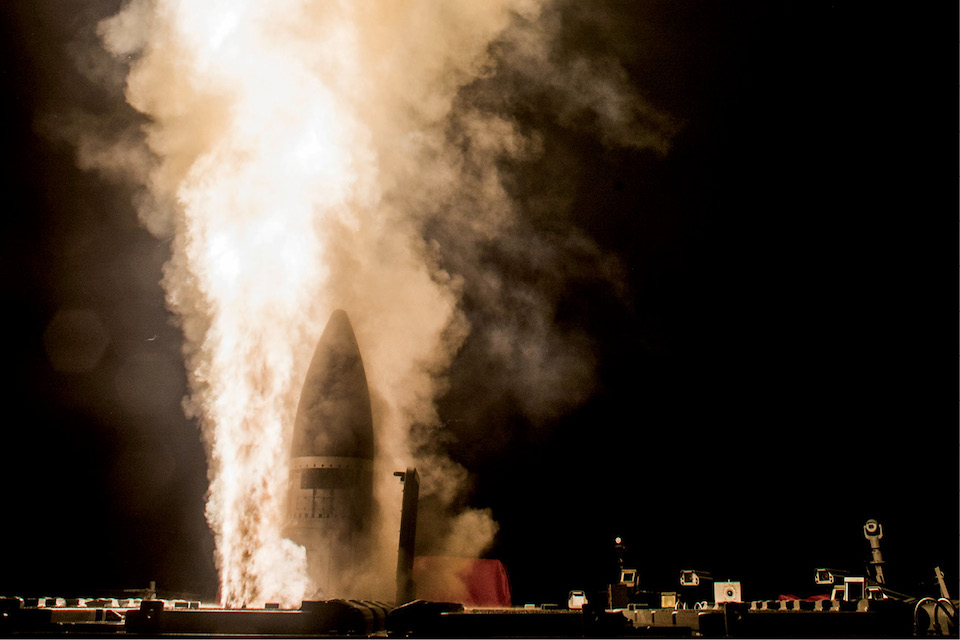
USS John Paul Jones launches Standard Missile-3 Block IIA during flight test off Hawaii, marking first successful intercept engagement using Aegis Baseline 9.C2 weapon system, February 2, 2017 (Missile Defense Agency)
The IAMD Construct
Joint Publication (JP) 3-01, Countering Air and Missile Threats, defines IAMD as the “integration of capabilities and overlapping operations to defend the homeland and U.S. national interests, protect the Joint Force, and enable freedom of action by negating an adversary’s ability to create adverse effects from their air and missile capabilities.”5 IAMD is nested under the counterair mission, integrating offensive and defensive operations to attain and maintain a degree of air superiority and protection by neutralizing or destroying enemy aircraft and missiles, both before and after launch. When evaluating the IAMD mission, adversary capabilities are typically categorized into air-breathing and non-air-breathing threats. Air threats comprise manned aircraft, unmanned aircraft systems (UAS), and aerodynamic missiles (to include cruise missiles). Non-air-breathing threats traditionally consisted of ballistic missiles with flight profiles capable of endoatmospheric and exoatmospheric standard ballistic trajectories. Additionally, rockets, artillery, and mortars—which are characteristically non-air-breathing, short-range threats with ballistic flight profiles—were recently included in the IAMD mission area as part of the April 2017 update to JP 3-01. Each of these threat categories poses unique technical and operational challenges that affect how the joint force should defend against them. Figure 1 depicts the various subcategories defined within or associated with IAMD.
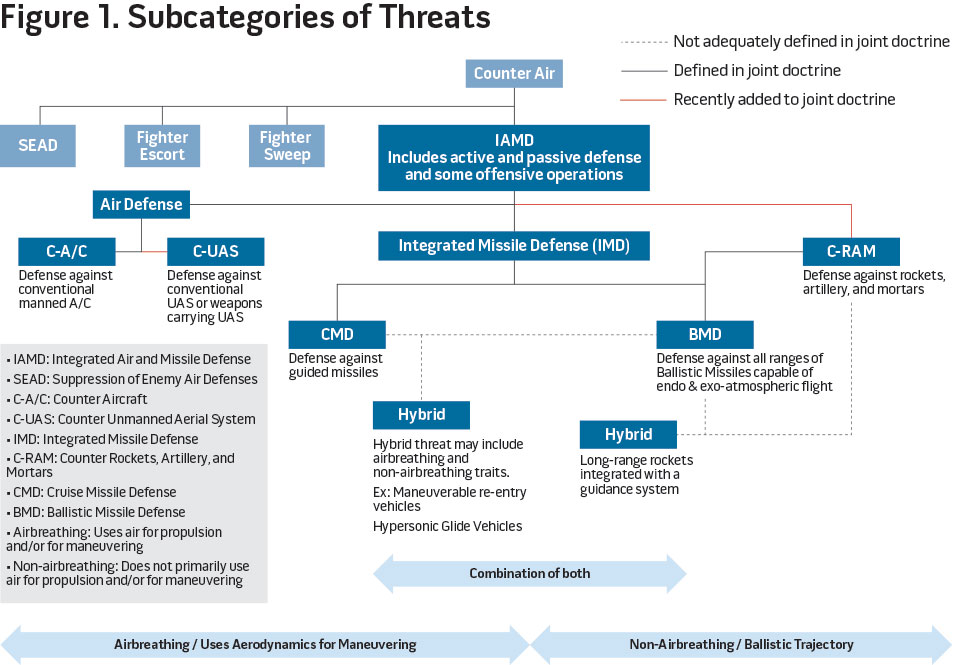
Advances in adversary air and missile capabilities are blurring the lines between traditional air-breathing and non-air-breathing threat categories, broadening the IAMD mission. Hybrid threats—such as a ballistic missile equipped with a maneuvering re-entry vehicle or hypersonic glide vehicle, a lethal one-way UAS, or long-range, large caliber rockets equipped with terminal guidance—demand a multilayered defense to eliminate exploitable gaps between traditional IAMD subcategories. Additionally, advances in longer range ballistic missiles, manned and unmanned aircraft, and cruise missiles present new challenges that require improved cross-combatant command integration. Further challenging the IAMD mission is the counter-rocket, -artillery, and -mortar (C-RAM) mission. The increased precision guidance capabilities of adversary rockets, artillery, and mortars countered by new technologies, such as the land-based Phalanx weapons system or Israel’s Iron Dome system, necessitated that joint doctrine be revised to incorporate this threat and C-RAM capabilities into IAMD. This revision to joint doctrine was necessary despite the traditional belief that the C-RAM mission is “not generally considered part of the centralized joint AMD [air and missile defense] network” because of the weapons’ localized effects in the battlefield.6
Solving Ballistic Missile Defense
Executing the IAMD mission is already complex, but it is further complicated by the organizational structure within DOD tasked to develop and execute it. The Defense Department’s disparate efforts for developing IAMD solutions provide a basis for examination of stakeholder organizations. To date, most of the efforts to address missile defense have focused on the integration of various ballistic missile defense (BMD) systems across the Services and deployed with the combatant commands (CCMDs). Many of the newer BMD systems utilize cutting-edge hit-to-kill technology to destroy incoming ballistic missiles targeting the homeland or friendly forces deployed in theater. The complexity of developing, fielding, and then integrating these advanced weapons systems into a cohesive BMD family of systems capable of defeating myriad ballistic missile threats has been a formidable undertaking; however, a significant hurdle to the development of BMD systems was the complicated organizational and bureaucratic structures within DOD.
In 2002, the threat of strategic ballistic missile attacks to the homeland prompted the George W. Bush administration to conclude that “all missile defense plans should be brought under one large umbrella.”7 However, the BMD mission does not fit singularly into any one of the military departments’ core mission areas. Therefore, DOD redesignated the Ballistic Missile Defense Organization as the Missile Defense Agency (MDA) and granted it “full agency rank and with it, the power and influence associated with such positioning.”8 The creation of MDA consolidated the responsibility for the lead development of the BMD system under one organization with authority to directly effect change and development in the joint force. With its own budget, personnel, and resources, MDA could focus on developing and integrating BMD systems in coordination with the Services, Joint Staff, and combatant commands. MDA authorities allowed the organization to better synchronize development of capabilities across DOD and invest in capabilities that may have been lower in priority for the separate military Services. The demonstrated capability to shoot down ballistic missiles launched toward the homeland or at friendly forces deployed in theater is a direct result of the creation of the MDA.
Overview of IAMD Structures
The emerging complex array of IAMD systems faces many of the same hurdles that challenged DOD development of BMD capabilities because IAMD similarly requires capabilities from all the Services to operate in and across areas of responsibility in each of the CCMDs. Analysis of the IAMD roles and responsibilities across DOD shows that there is no single entity with the authority and resources to effectively and efficiently develop, field, and operate joint IAMD capabilities. Instead, the joint IAMD mission area requires numerous DOD organizations to develop, field, and operate disparate IAMD capabilities.
Each of the organizations in the IAMD enterprise contributes differently by performing one or more of the following functions: force readiness, capability gap, and requirements assessment; lead advocacy for budgeting/capability requirements, doctrine/tactics, techniques, and procedures (TTPs) development; joint training; global exercise; system architectures/technical requirements; operational support; and acquisition execution. While these functions are not unique to how DOD executes the IAMD mission, the challenge is that a large set of diverse organizations perform one or more of these different functions for various capabilities to address one or more subsets of the IAMD threat. Figure 2 depicts the multiple organizations executing different functions to counter a variety of threat subsets. It is important to note this figure is not all-inclusive.
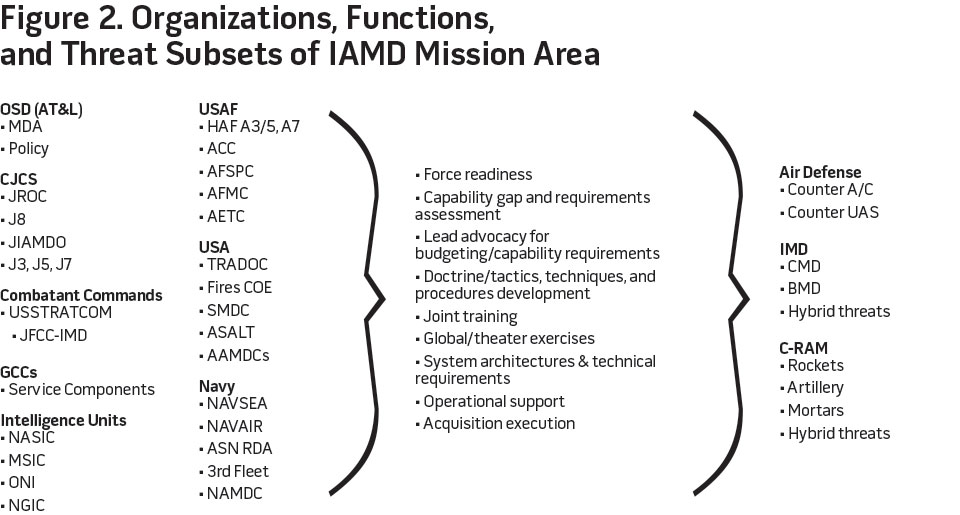
The 2005 Unified Command Plan assigned U.S. Strategic Command (USSTRATCOM) the role of “global synchronizer” for integrated missile defense (IMD). To execute this mission, USSTRATCOM created the Joint Functional Component Command for Integrated Missile Defense (JFCC-IMD). In doing so, USSTRATCOM leveraged the Army’s Space and Missile Defense Command’s (SMDC) commanding general, who also serves as the commanding general for Army Strategic Command, and designated him as the commanding general for JFCC-IMD, resulting in a tri-hatted position. In 2007, the JFCC-IMD and SMDC commanding general, Lieutenant General Kevin T. Campbell, wrote that “the primary mission [of JFCC-IMD] is to conduct functions for global missile defense to protect the United States, its deployed forces, friends, and allies from ballistic missile attacks” and to synchronize BMD needs and operations across the combatant commands.9 Although the original scope of JFCC-IMD was on integrated ballistic missile defense only, that mission area is expanding to include defense of cruise missiles and hypersonic missile threats. The joint community is currently considering ways to better define the USSTRATCOM role in integrated missile defense because the term global synchronizer is not properly defined in doctrine or used in other references.
To complicate matters further, in 2008, the USSTRATCOM commander was also designated the Air and Missile Defense Integrating Authority (AMD IA). In this role, the USSTRATCOM commander not only was responsible for synchronizing global IMD per the Unified Command Plan but also had to act as the lead integrating authority for all IAMD capabilities across DOD. The AMD IA’s chartered mission was to “provide a collaborative means for combatant commands, Military Departments, and Defense Agencies to identify and assess desired AMD capabilities and characteristics, examine the operational risks associated with capability gaps and redundancies, and review possible solutions and implementation timelines to support programmatic and milestone decisions.”10 The additional AMD IA mission forced USSTRATCOM to again leverage another organization, the Joint Integrated Air and Missile Defense Organization (JIAMDO). In 2015, USSTRATCOM’s role as AMD IA was disestablished because of resourcing, and the majority of AMD IA responsibilities fell onto JIAMDO.
JIAMDO is another key organization within the IAMD enterprise. It was established as a Chairman of the Joint Chiefs of Staff (CJCS) Controlled Activity that reports to the Chairman through the Joint Staff J8 Directorate. (“CCAs [Chairman’s Controlled Activities] are specialized organizations designed to address unique areas that are of joint interest.”) JIAMDO is chartered to support both the CJCS and USSTRATCOM in their efforts “to develop and integrate sensors, weapons, command and control systems, and the concepts to employ them in the air and missile defense mission area.”11 While JIAMDO’s authority is primarily limited to performing the J8 function for the CJCS in that it provides “support to CJCS for evaluating and developing force structure requirements,” it additionally assisted USSTRATCOM as the AMD IA to “advocate for warfighter’s desired IAMD capabilities within DOD’s capability identification, development, budgetary and acquisition process” before the AMD IA role was disestablished.12 In 2017, the Deputy Secretary of Defense removed JIAMDO’s designation as a CCA, but JIAMDO still provides the Chairman and combatant command assessment and analysis for the BMD, IMD, and remaining IAMD mission areas so that DOD leadership, including those from the military departments, can make informed recommendations and resourcing decisions.
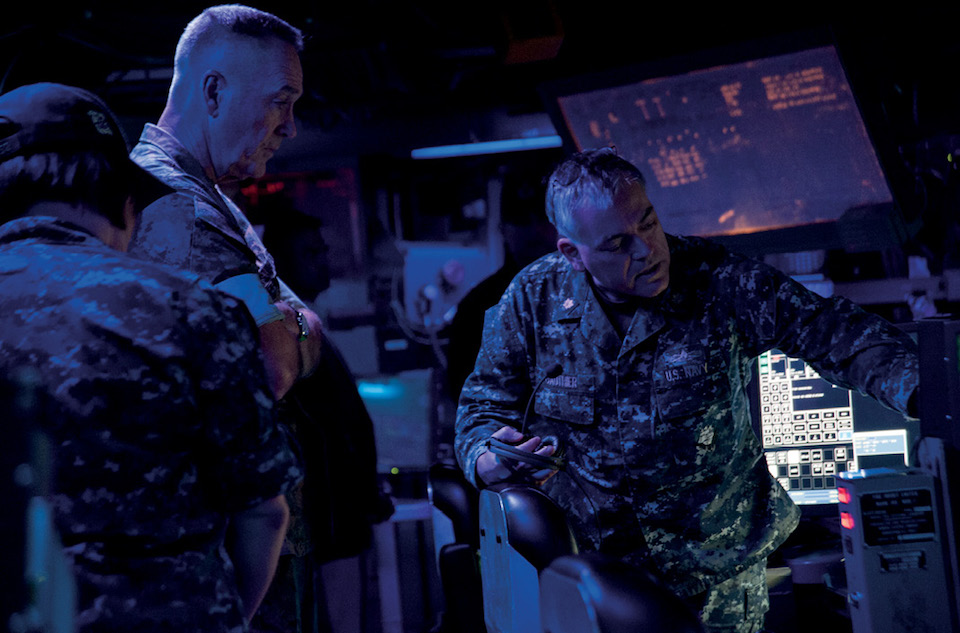
Chairman discusses capabilities of USS Barry during tour of ship and Aegis Baseline 9.C2 weapon system, which includes air and ballistic missile defense, surface warfare, and undersea warfare capabilities, Yokosuka, Japan, September 7, 2016 (U.S. Navy/Leonard Adams)
While MDA is chartered to focus on the development of BMD capabilities, in 2013 it was assigned the role of IAMD Technical Authority (TA) to “lead IAMD engineering and integration efforts to enable joint capability.”13 In this capacity, the IAMD TA can create and recommend system standards, modifications, and other joint technical requirements to close gaps in interoperability and facilitate integrating IAMD capabilities across DOD. This is especially important in establishing a joint architecture for command, control, and communications of IAMD elements across the Services. The IAMD TA role is limited in that it does not have the authority to execute its recommendations. The military departments must be the organizations that plan, budget, and execute those requirements that the Services determine are worth the investment.
Each military department provides major contributions to the IAMD mission area, but departments also have other missions and priorities to balance. The military departments are responsible for organizing, training, and equipping military forces for combatant commanders and ensuring the U.S. military can conduct operations in current conflicts while balancing risks of future potential conflicts. As such, any IAMD capability will rely heavily on the programmatic investments made by the Services, but the Services’ cultures, priorities, and available resources will likely dictate how they view and prioritize IAMD.
The U.S. Air Force views IAMD as a subset of the much larger counterair mission area, as described in JP 3-01. One of the Air Force priorities for the joint force has been to obtain and maintain air and space superiority, a core mission. The air and space superiority mission requires much more than IAMD capabilities, and, with that context in mind, one can understand why the Air Force may be less focused on certain areas within IAMD. On the contrary, JP 3-30, Command and Control of Joint Air Operations, states that the Joint Force Air Component Commander (JFACC) may also be designated as the Area Air Defense Commander (AADC).14 In more recent combat operations, the Air Force has been designated as the JFACC and AADC; however, the Air Force does not own most of the active IAMD capabilities, which are generally provided by the Army or Navy. Nonetheless, with limited resources, the Air Force will continue to support capabilities vital to its core missions, functions, and the joint force.
The Navy sees IAMD in two major mission areas: self-protection of its vital carrier assets and, more recently, BMD for critical assets. Given the nature of maritime operations, the Navy must be able to protect its assets from a diversity of threats to ensure they can support joint operations. Advances in ballistic missile systems are making them more accurate in targeting U.S. ships at sea. The Navy, working closely with the MDA, has fielded capable BMD assets associated with their Aegis SPY-1 radar and standard missile variants, proving itself critically important to BMD. Today, the Aegis weapons system has proved capable of defeating ballistic missile threats because a single cruiser, destroyer, or Aegis Ashore provides the ability to find, fix, target, track, engage, and assess a variety of threats.
The Army views IAMD as providing protection for critical assets and ground maneuver forces. Historically, Army IAMD forces focused on defending ground forces to support movement, maneuver, and protection; however, since the joint force has maintained air superiority over the past 30 years of conflicts, the focus of the Army’s air defense artillery has shifted to the defense of fixed critical assets, facilities, and infrastructure centered on BMD and C-RAM. This has more recently come at the expense of traditional short-range air defense (SHORAD) capabilities that could be used to counter air-breathing threats such as manned/unmanned aircraft systems and cruise missiles. With the evolution and proliferation of adversary cruise missiles and UAS, the Army is shifting its focus back to development of SHORAD units with the indirect fire protection capability that will again provide air defense coverage of maneuvering ground forces.
Ideas to Consider for Improvement
While developing a comprehensive solution to DOD IAMD organizational challenges may prove too difficult, improving the construct and its efficiency is fundamentally easier. Any ideas—big, small, radical, or simple—could result in positive impacts on the joint force. Although recommending full solutions is beyond the scope of this article, the following are ideas decisionmakers could consider to provoke further discussion about how DOD could improve the current IAMD enterprise construct.
DOD could create a new dedicated three-star joint IAMD command or agency with the mission, manpower, expertise, and authorities to integrate IAMD capabilities across DOD. This organization could focus on functions and needs that cross organizational roles and responsibilities and use its resources to implement technical solutions in DOD acquisition programs or focus on TTPs and nonmaterial solutions to solve combatant command needs. To accomplish these and other missions, this organization would require an appropriate budget authority to influence change across DOD and Service acquisition programs. This budget authority could be used to fund the development of IAMD capabilities or establish and fund joint IAMD requirements in Service acquisition programs that may otherwise not receive Service priority and funding. Alternatively, this organization could use the resources to better focus the joint IAMD community on developing integrated TTPs or championing and funding innovative concepts to more effectively use existing IAMD capabilities. To do this, the organization needs the capability to support combatant commands in analyzing potential solutions to IAMD challenges and to support cost-versus-benefit analysis of future investments. This joint organization could also increase our effectiveness in the IAMD mission set by using its manpower and budget authority to influence improvement across DOD.
Similarly, DOD could focus on more effectively executing a smaller piece of the IAMD mission area—missile defense—by better enabling, resourcing, and empowering USSTRATCOM’s JFCC-IMD with a dedicated three-star billet, support staff, subject matter experts, and a larger budget authority. DOD could also analyze broadening the MDA mission set to include developing capabilities to defend against all types of missiles, not just ballistic ones. This could concentrate the DOD effort in missile defense by establishing a single organization responsible for the acquisition of DOD missile defense capabilities within the greater IAMD mission area.
DOD could look at reconfiguring the roles and responsibilities of the Services. In 2011, the Russian military combined its air force, air and missile defense troops, and space forces into a combined Aerospace Force. While this may not work for the U.S. military, we may find utility in reallocating ground air defense systems to the Air Force or rearranging other missions to consolidate more IAMD responsibilities into a Service. This would allow the Service to better integrate those capabilities into its command and control structure, facilitating training among other potential benefits.
Additionally, DOD could create a Joint Acquisition Executive (JAE) to support IAMD (and other joint) acquisition programs. As former Defense Secretary Robert Gates stated, “We have really come to a point where we do extraordinarily well in terms of joint operations, but we do not do well in terms of joint procurement. It is still very Service-centered.”15 The Defense Science Board concluded that a “JAE would be more motivated than a Service-specific Acquisition Executive to resist individual Service culture, parochialism, and component-unique requirements and is more likely to reach out to CCMDs for requirements, both before program initiation and after baseline requirements have been set.”16 Having a JAE could reduce the stovepiped nature of the departments and agencies that operate in their own priorities and that often center their attention on major platforms rather than capabilities.17
Furthermore, DOD could create general officer– or flag officer–level IAMD centers of excellence within each of the Services and combatant commands. These centers could, with the proper authorities, establish a dedicated cadre of IAMD operators and subject matter experts to enhance and facilitate communication on cross-cutting IAMD challenges, training issues, and requirements. As an example, Pacific Air Forces recently established the Pacific IAMD Center, which will train theater, joint, and international IAMD professionals and coordinate IAMD exercises and training events, all while engaging with allies and partners dedicated to regional defense.18 To further improve coordination and integration of IAMD capabilities, combatant commands could operationalize and staff a dedicated and collaborative air and missile defense board akin to the well-known and practiced joint targeting coordination board, or to the joint collection management board.19 Establishing this type of board and working groups and codifying them into doctrine could increase the joint IAMD planning and coordination support to the joint force commanders.20 All of these IAMD centers or air and missile defense boards could be used to more easily collaborate across areas of responsibility or organizations by creating known IAMD groups with which to collaborate.
These ideas are by no means all-inclusive, without their disadvantages, or even politically feasible, but they demonstrate that concepts for improvement could come in many forms to support the challenges of fielding and operating IAMD capabilities.
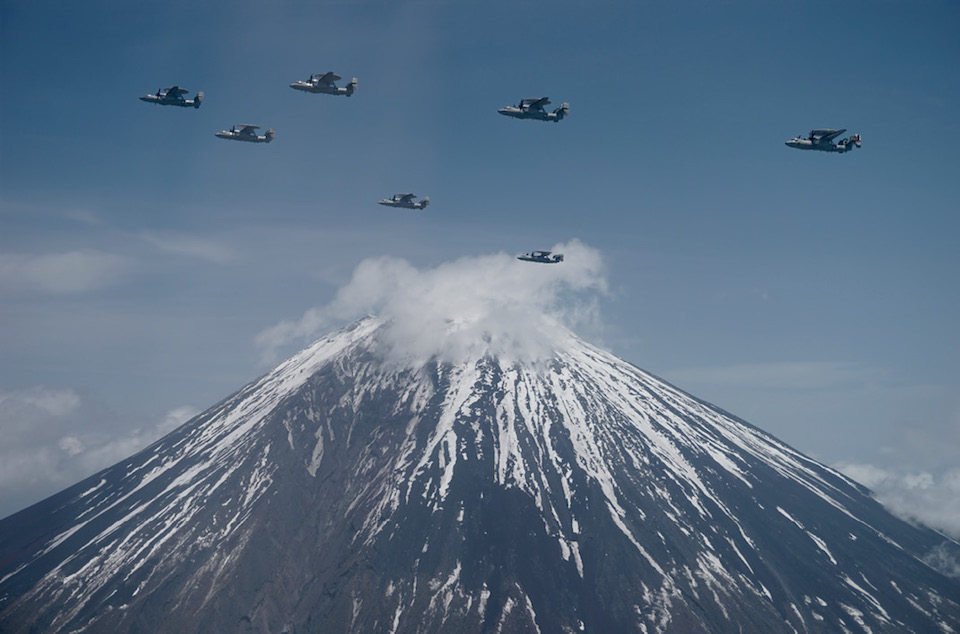
Above Mount Fuji, five E-2D Advanced Hawkeyes, stationed at Marine Corps Air Station Iwakuni, Japan, lead two E-2C Hawkeyes, stationed at Naval Air Facility Atsugi, Japan, as part of Asia-Pacific rebalance, May 11, 2017 (U.S. Navy/Artur Sedrakyan)
Conclusion
As the complexity of air, cruise, and ballistic missile threats quickly evolves over the next 10 to 20 years, DOD must find a less complicated way to rapidly develop and integrate the Services’ IAMD capabilities and employ them across CCMD boundaries. How DOD is currently organized and how it manages the IAMD threat do not allow the joint force the ability to comprehensively counter this evolving and increasingly complex threat with the degree of agility required. If DOD fails in this endeavor, the United States and its allies risk losing more than just access to the global commons—the U.S. military risks losing current advantages in the land, sea, and air domains.
The current IAMD enterprise organizational construct can be streamlined and empowered to simplify the process in which DOD deals with IAMD. While some proposed solutions require significant change or restructuring, it is important that DOD continue to focus on how to improve its responsiveness and the integration of IAMD capabilities even with the influence of organizational resistance, Service cultures, and parochialism. The key to any proposed ideas for improvement will most likely require the clarification, specification, and consolidation of roles, responsibilities, and budget authorities to effect change within the IAMD enterprise. The results would be more effective organizations that are better focused on IAMD and enabled by the right set of authorities, personnel, resources, and budget to achieve a more agile and responsive joint force. The joint force cannot afford to maintain the status quo, but must evolve DOD’s IAMD construct to mitigate current and future risks and make an increasingly complex problem less complicated. JFQ
Notes
1 Joint Integrated Air and Missile Defense: Vision 2020 (Washington, DC: The Joint Staff, 2013), available at <www.jcs.mil/Portals/36/Documents/Publications/JointIAMDVision2020.pdf>.
2 Geoffrey F. Weiss, “Seeing 2020: America’s New Vision for Integrated Air and Missile Defense,” Joint Force Quarterly 76 (1st Quarter 2015), 108.
3 Ibid.
4 William F. Bell, “Have Adversary Missiles Become a Revolution in Military Affairs?” Air & Space Power Journal, September–October 2014, 48–62.
5 Joint Publication (JP) 3-01, Countering Air and Missile Threats (Washington, DC: The Joint Staff, 2017), available at <www.dtic.mil/doctrine/new_pubs/jp3_01.pdf>.
6 Ibid.
7 Bradley Graham, Hit to Kill: The New Battle Over Shielding America from Missile Attack (New York: PublicAffairs, 2003), 187–190, 199–200.
8 Richard D. Burns and Lester H. Brune, The Quest for Missile Defenses, 1944–2003 (Claremont, CA: Regina Books, 2003), 148.
9 Kevin T. Campbell, “Integrated Missile Defense,” Joint Force Quarterly 46 (3rd Quarter 2007), 64.
10 Gordon R. England, “Designation of the Commander, U.S. Strategic Command, as the Air and Missile Defense Integrating Authority (AMD IA),” January 17, 2008, 2.
11 Chairman of the Joint Chiefs of Staff Instruction 5125.01, Charter of the Joint Information Operations Warfare Center (Washington, DC: The Joint Staff, September 30, 2015), available at <www.jcs.mil/LinkClick.aspx?fileticket=JNiikxjVtt0%3d&tabid=19767&portalid=36&mid=46626>; James E. Cartwright, “Joint Theater Air and Missile Defense Organization Charter,” JROCM 066-08, March 17, 2008, 1.
12 Cartwright.
13 Frank Kendall, “Ballistic Missile Defense System Acquisition Decision Memorandum,” May 8, 2013, 1.
14 JP 3-30, Command and Control of Joint Air Operations (Washington, DC: The Joint Staff, February 10, 2014).
15 “Gates Sees Opportunity for Additional Weapon System Kills Info,” InsideDefense.com, April 7, 2009.
16 Defense Science Board, Report of the Defense Science Board: Fulfillment of Urgent Operational Needs, Report No. ADA503382 (Washington, DC: Office of the Under Secretary of Defense for Acquisition, Technology, and Logistics, 2009).
17 Howard Harris and Mark Lewis, “Proposed Leadership Structure for Joint Acquisition Programs,” Defense Acquisition Review Journal 19, no. 1 (January 2012), 38–39.
18 Ibid.
19 Kenneth Dorner, William Hartman, and Jason Teague, “Back to the Future: Integrated Air and Missile Defense in the Pacific,” Air and Space Power Journal 29, no. 1 (January–February 2015), 61.
20 S. Edward Boxx and Jason Schuyler, “The Case for the Joint Theater Air Missile Defense Board,” Joint Force Quarterly 79 (4th Quarter 2015), 83.